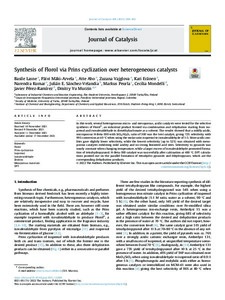| dc.contributor.author | Eränen Kari | |
| dc.contributor.author | Pérez-Ramírez Javier | |
| dc.contributor.author | Mäki-Arvela Päivi | |
| dc.contributor.author | Sánchez-Velandia Julián E. | |
| dc.contributor.author | Lasne Basile | |
| dc.contributor.author | Kumar Nanendra | |
| dc.contributor.author | Mondelli Cecilia | |
| dc.contributor.author | Peurla Markus | |
| dc.contributor.author | Vajglova Zuzana | |
| dc.contributor.author | Murzin Dmitry Yu | |
| dc.contributor.author | Aho Atte | |
| dc.date.accessioned | 2022-10-28T13:35:30Z | |
| dc.date.available | 2022-10-28T13:35:30Z | |
| dc.identifier.uri | https://www.utupub.fi/handle/10024/166065 | |
| dc.description.abstract | In this work, several heterogeneous micro- and mesoporous, acidic catalysts were tested for the selective synthesis of Florol (R), an industrial product formed via condensation and rehydration starting from isoprenol and isovaleraldehyde in dimethylcarbonate as a solvent. The results showed that a mildly acidic, microporous H-Beta-300 with SiO2/Al2O3 ratio of 300 was the best catalyst, giving 72% selectivity with 99% conversion at 40 degrees C when using the molar ratio isoprenol to isovaleraldehyde of 1:5. More acidic zeolites gave slightly lower selectivity, while the lowest selectivity (up to 52%) was obtained with mesoporous catalysts exhibiting mild acidity and no strong Bronsted acid sites. Selectivity to pyranols was nearly constant when changing temperature, while a larger excess of isovaleraldehyde promoted formation of tetrahydropyranol. H-Beta-300 catalyst was successfully after calcination at 400 degrees C. DFT calculations pointed out on the parallel formation of tetrahydro pyranols and dihydropyrans, which are the corresponding dehydration products. (C) 2021 Elsevier Inc. All rights reserved. | |
| dc.language.iso | en | |
| dc.publisher | ACADEMIC PRESS INC ELSEVIER SCIENCE | |
| dc.title | Synthesis of Florol via Prins cyclization over heterogeneous catalysts | |
| dc.identifier.urn | URN:NBN:fi-fe2022081154873 | |
| dc.relation.volume | 405 | |
| dc.contributor.organization | fi=biolääketieteen laitos, yhteiset|en=Institute of Biomedicine| | |
| dc.contributor.organization-code | 2607100 | |
| dc.converis.publication-id | 174831065 | |
| dc.converis.url | https://research.utu.fi/converis/portal/Publication/174831065 | |
| dc.format.pagerange | 302 | |
| dc.format.pagerange | 288 | |
| dc.identifier.eissn | 1090-2694 | |
| dc.identifier.jour-issn | 0021-9517 | |
| dc.okm.affiliatedauthor | Peurla, Markus | |
| dc.okm.discipline | 215 Chemical engineering | en_GB |
| dc.okm.discipline | 215 Teknillinen kemia, kemian prosessitekniikka | fi_FI |
| dc.okm.internationalcopublication | international co-publication | |
| dc.okm.internationality | International publication | |
| dc.okm.type | Journal article | |
| dc.publisher.country | United States | en_GB |
| dc.publisher.country | Yhdysvallat (USA) | fi_FI |
| dc.publisher.country-code | US | |
| dc.relation.doi | 10.1016/j.jcat.2021.12.008 | |
| dc.relation.ispartofjournal | Journal of Catalysis | |
| dc.year.issued | 2022 | |
